Analyzing the Key Drivers Behind the Recent Surge in ETH Prices
Author: Biteye Core Contributor @viee7227
Ethereum has seen a decade of ups and downs, and as the market heats up again, the price of ETH seems just a step away from its historical high.
This article analyzes seven major dimensions, including institutional accumulation and the ETF craze, changes in foundations, K-line technical indicators, on-chain data, roadmaps, RWA, and the rise of stablecoins. Perhaps this round of Ethereum's rise has just begun.
1. ETH Reserve Concept Stocks
Recently, the buying pressure in the ETH market has been exceptionally strong, with many listed companies and asset management institutions actively increasing their holdings, even incorporating ETH into their financial strategies. At the same time, ETH reserve concept stocks have surged, becoming a new favorite in the U.S. stock market.
A landmark event that triggered Wall Street's embrace of Ethereum was the high-profile bet on ETH by Thomas Lee, a well-known strategist and co-founder of Fundstrat. He will serve as the chairman of Bitmine in 2025, directly driving the transformation of this former Bitcoin mining company into an Ethereum asset company. Under Lee's leadership, Bitmine quickly accumulated over 600,000 ETH positions in the market, valued at over $3 billion, as a major asset in its financial reserves. It was also under his marketing inspiration that Wall Street's excitement was ignited, with several U.S. listed companies announcing their purchase of ETH as part of their asset allocation. For example, Bit Digital converted its BTC holdings into ETH, spending $172 million to acquire 100,000 ETH, which has now exceeded 120,000; SharpLink Gaming currently holds approximately 438,000 ETH, valued at about $1.09 billion.
This series of actions indicates that institutional investors are viewing Ethereum as a strategic reserve asset similar to Bitcoin, significantly enhancing Ethereum's market recognition and further strengthening bullish expectations.
2. ETF
With the surge in ETH prices, substantial off-exchange funds have flowed into Ethereum ETFs.
According to SoSoValue data, on July 29, Eastern Time, the total net inflow into Ethereum spot ETFs reached $219 million, continuing a net inflow for 18 consecutive days since July 3. The Ethereum spot ETF with the highest single-day net inflow was Blackrock's ETF ETHA, which saw a net inflow of $224 million in one day, bringing its historical total net inflow to $9.704 billion. On July 16, nine U.S. spot Ethereum ETFs collectively attracted over $726 million in net inflows, setting a single-day record since their launch in July last year.
In contrast, during the same period, U.S. Bitcoin ETFs cooled off after an initial surge at the beginning of the year, experiencing several days of slight net outflows in late July. This indicates that some funds are being rebalanced from the BTC sector to the ETH sector, reflecting increased institutional confidence in Ethereum's application prospects. Currently, the market capitalization of Bitcoin ETFs accounts for 6.49% of Bitcoin's total market value, while Ethereum ETFs account for only 4.71%, indicating that there is still significant growth potential for funds flowing into Ethereum through ETF channels.

Source: SoSoValue
Looking ahead, in addition to spot ETFs, Ethereum staking yield ETFs are also on the way. On July 17, Blackrock's iShares Ethereum Trust Fund (ETHA) officially submitted a 19b-4 filing to the SEC, intending to introduce staking features for its Ethereum ETF. According to analysts' predictions, the U.S. is expected to approve the first batch of ETH staking ETFs in the second half of 2025. These products will provide an annualized staking yield of 3-5% based on holding spot Ethereum, making them more attractive to institutions.
The most direct impact of the ETF effect on Ethereum is the enhancement of liquidity and demand ceilings. After allocating BTC ETFs, ETH ETFs have become the only option moving forward. With ETFs, large funds in the hundreds of billions can conveniently allocate assets, significantly enhancing ETH's investment attributes and market depth, making it one of the important external factors supporting a long-term bullish outlook.
3. Ethereum Foundation
The recent strength of Ethereum is also closely related to changes in its management team.
The Ethereum Foundation has undergone management adjustments over the past year. In March 2025, Hsiao-Wei Wang and Tomasz Stańczak were appointed as co-executive directors of the foundation. This dual-leadership model will decentralize decision-making and reduce single-point dependency, while also introducing more professional management beyond technical leaders like Vitalik, promoting efficiency. It retains the community-driven open-source spirit while enhancing external communication and strategic execution, facilitating positive interactions between Ethereum and institutions and regulators.
Additionally, former core researcher of the Ethereum Foundation, Danny Ryan, joined the Etherealize project founded by former banker Vivek Raman, aiming to bring ETH into the mainstream financial system on Wall Street through education and market promotion. This marks the first time the core Ethereum team has actively integrated into the traditional financial ecosystem, and the valuation logic of ETH will shift towards institutionalization, significantly enhancing long-term price support.
4. K-line Technical Indicators
Ethereum has recently shown a strong upward trend. Over the past month, the price of ETH has surged approximately 60% from around $2,400, nearing the $4,000 mark in late July. This increase far exceeds the market average, reflecting optimistic expectations for Ethereum.
From a technical perspective, the ETH/BTC pair ended a long period of sideways consolidation over the past three months and broke through a key range upward in mid-July, rising 40% in a single month. This indicates a shift in market preference from Bitcoin-dominated funds to Ethereum, with a resurgence in the market's preference for risk assets.
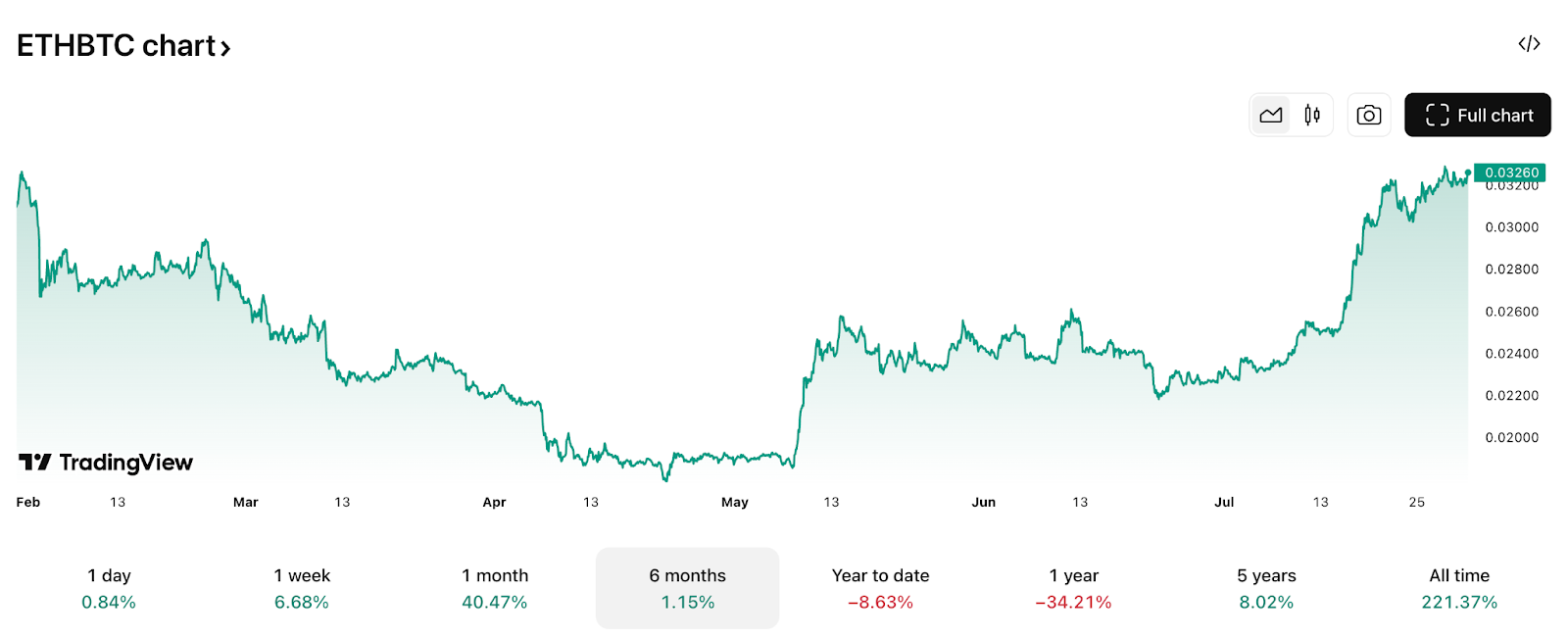
Source: TradingView
Additionally, ETH's RSI (Relative Strength Index) fell to around 30 on the weekly K-line in April, which is traditionally seen as a "buying zone at the low." Data shows that whenever the RSI reaches this range (30-40), ETH often experiences a significant upward surge. For instance, during the 2023-2024 period, the last occurrence of the same signal was accompanied by a 290% increase in ETH.
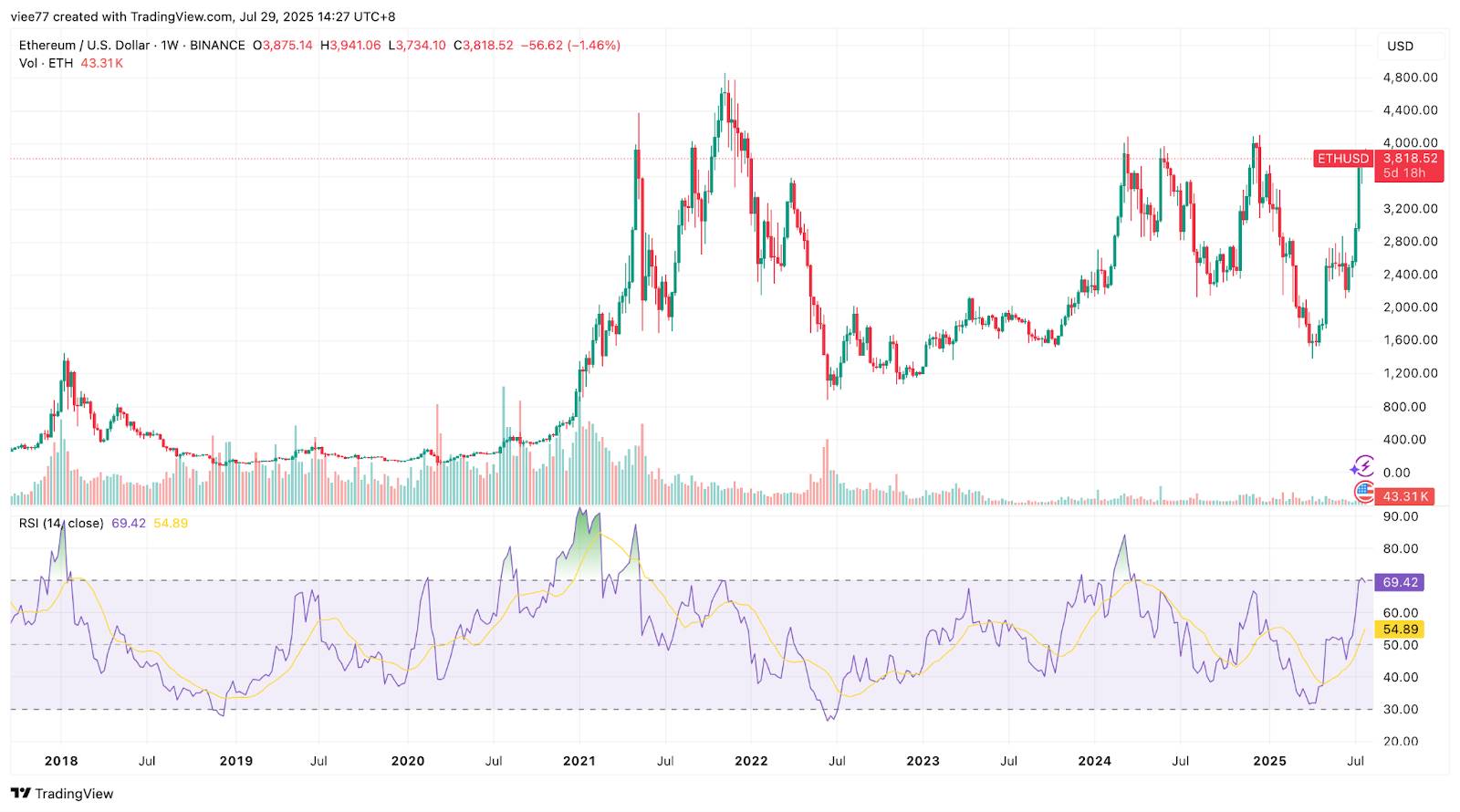
Source: TradingView
Analyst @MikybullCrypto pointed out this buying signal back in April, stating that it was an "extremely rare buying point that should not be ignored," predicting that ETH would double thereafter. He recently reiterated this view, suggesting that if the RSI continues to rise to high levels, the price of Ethereum could reach the $7,000 to $10,000 range.
This indicates that, from a technical standpoint, Ethereum's current upward trend may not be over yet.
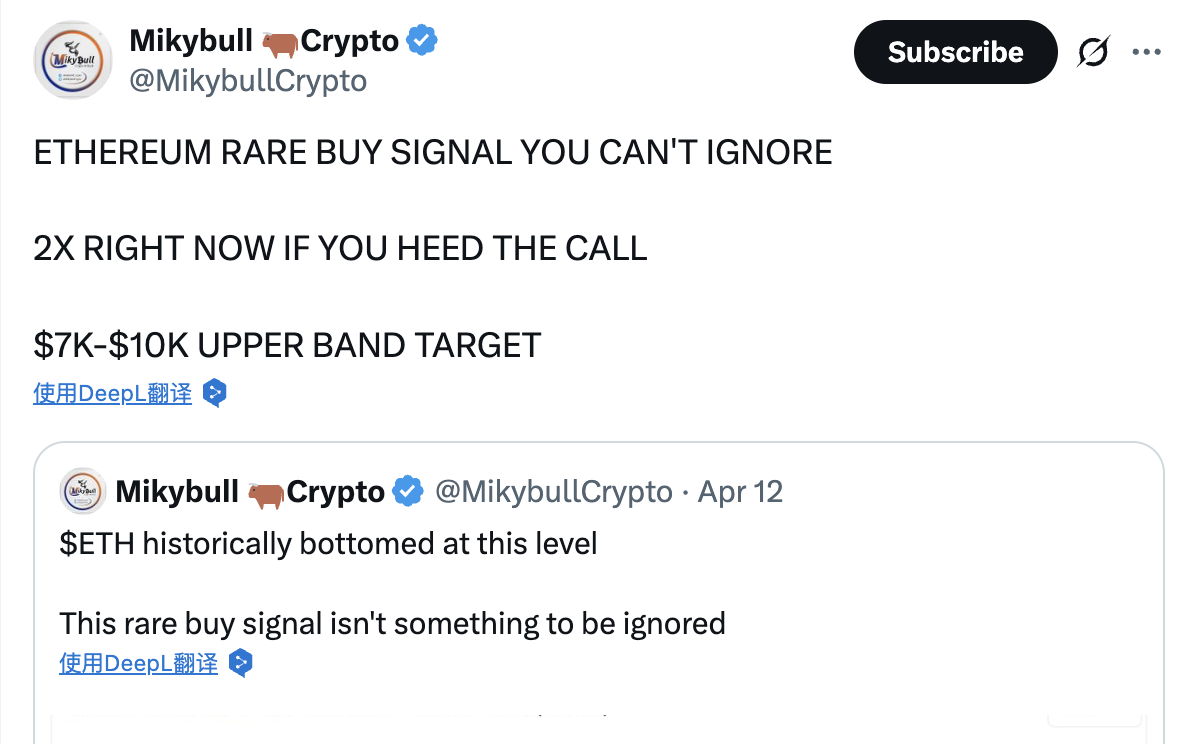
https://x.com/MikybullCrypto/status/1945580696140919266
5. On-chain Indicators
From on-chain data, Ethereum's activity has significantly increased.
Transaction Activity: The daily average number of transactions on the Ethereum mainnet has remained stable in recent months, with approximately 42 million monthly transactions in June 2025 (about 1.4 million daily), roughly in line with previous months. Notably, although on-chain gas fees are currently low, this may not be due to a decrease in users, but rather an increase in network processing capacity following the mainnet upgrade, leading to lower unit transaction costs. According to Nansen data, the number of active addresses on Ethereum has grown by 16.3% over the past 30 days, and the number of transactions has increased by 14.2% in the same period, reaching an average of 1.62 million daily transactions on July 22, a new high in nearly six months. The active on-chain activity indicates that more users and applications are utilizing the Ethereum network.
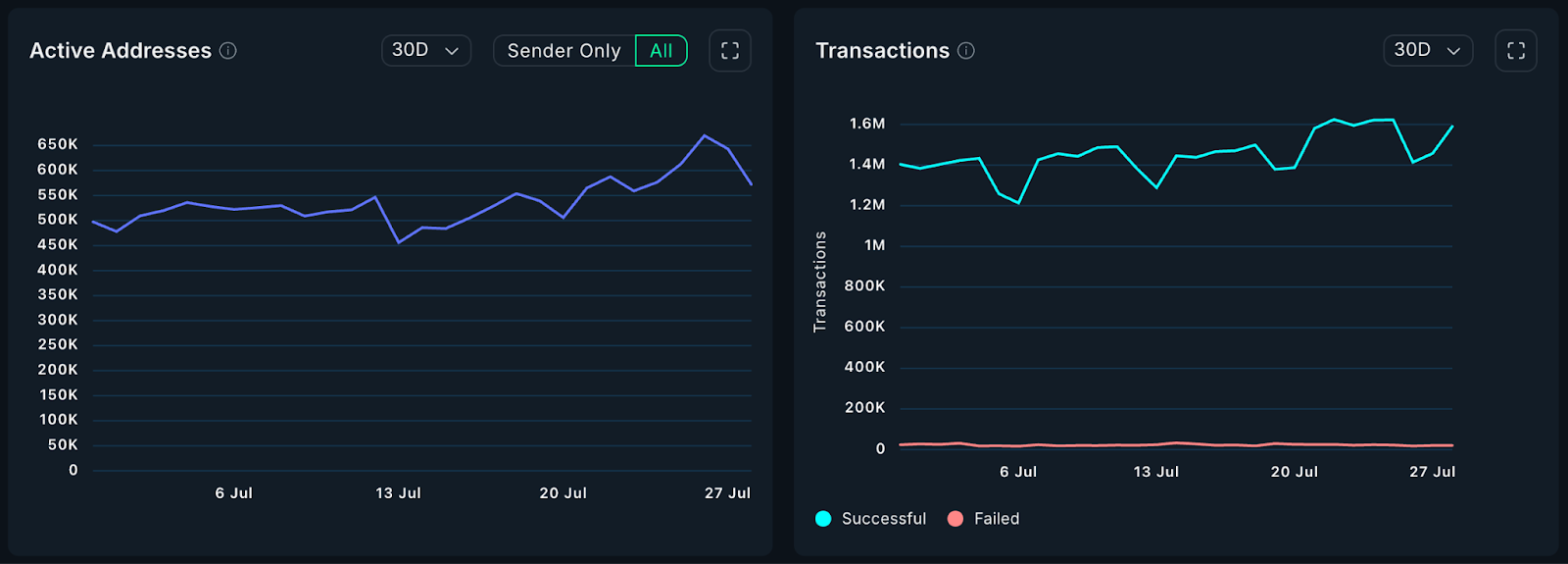
Source: Nansen
On-chain Fees: With the recent recovery in coin prices and on-chain activity, Ethereum's fee income has also rebounded, surpassing other public chains, and returning to the second position in on-chain fee income in the second quarter of 2025. According to Artemis data, Ethereum's total fee income for June was approximately $39.1 million, second only to Tron, reflecting a return of demand for the Ethereum network to some extent.
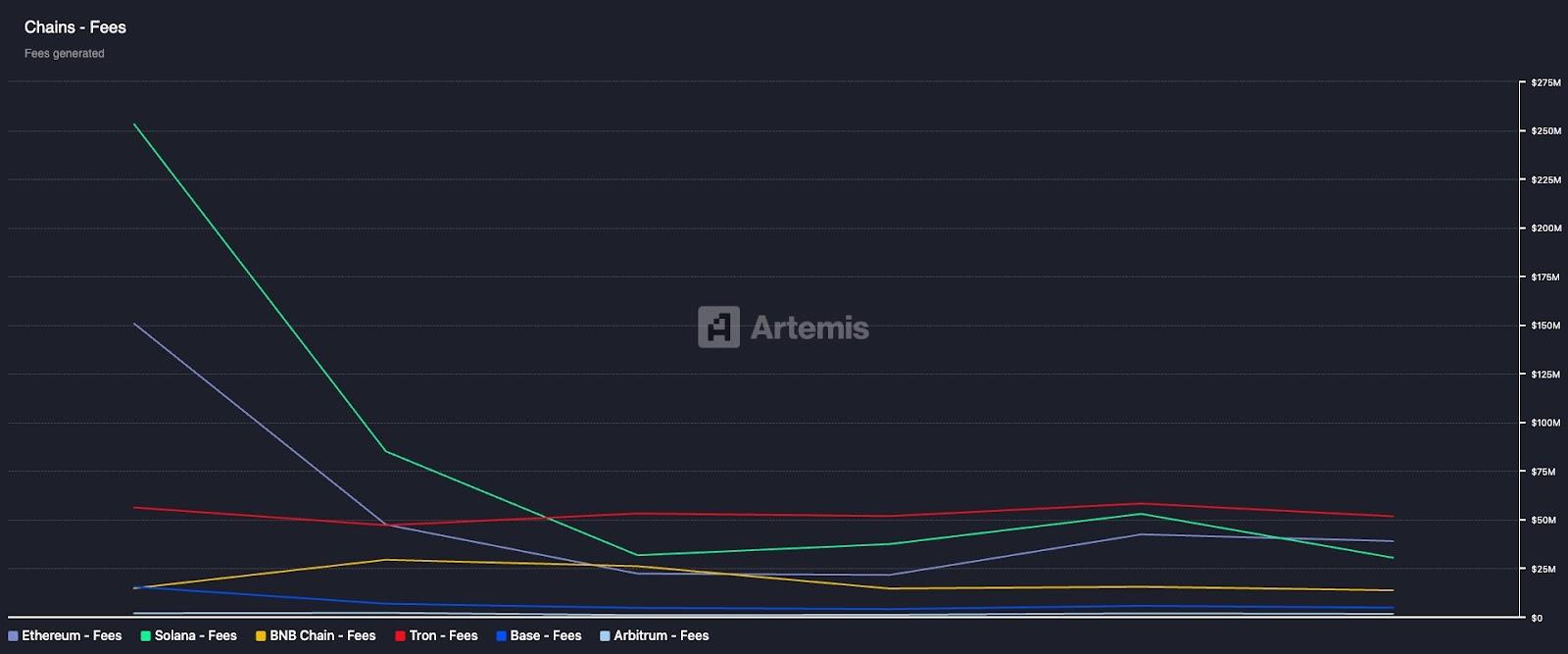
Source: Artemis
Total Value Locked (TVL) in DeFi: The following chart from DefiLlama shows that Ethereum's TVL rose from $60.2 billion on June 28 to a three-year high of $85.9 billion on July 28, an increase of over 42% within the month. Additionally, the total TVL across the network surpassed $153 billion in late July, setting a new three-year high, with nearly 60% locked in Ethereum. However, it is worth noting that Ethereum's price growth during the same period was 59.9%, exceeding the TVL growth rate. Moreover, when measured in ETH terms, the TVL growth rate showed a 1% decline, indicating that the recent TVL record high was primarily driven by the price increase of ETH. This suggests that if asset prices correct in the future, the TVL indicator may also decline accordingly.
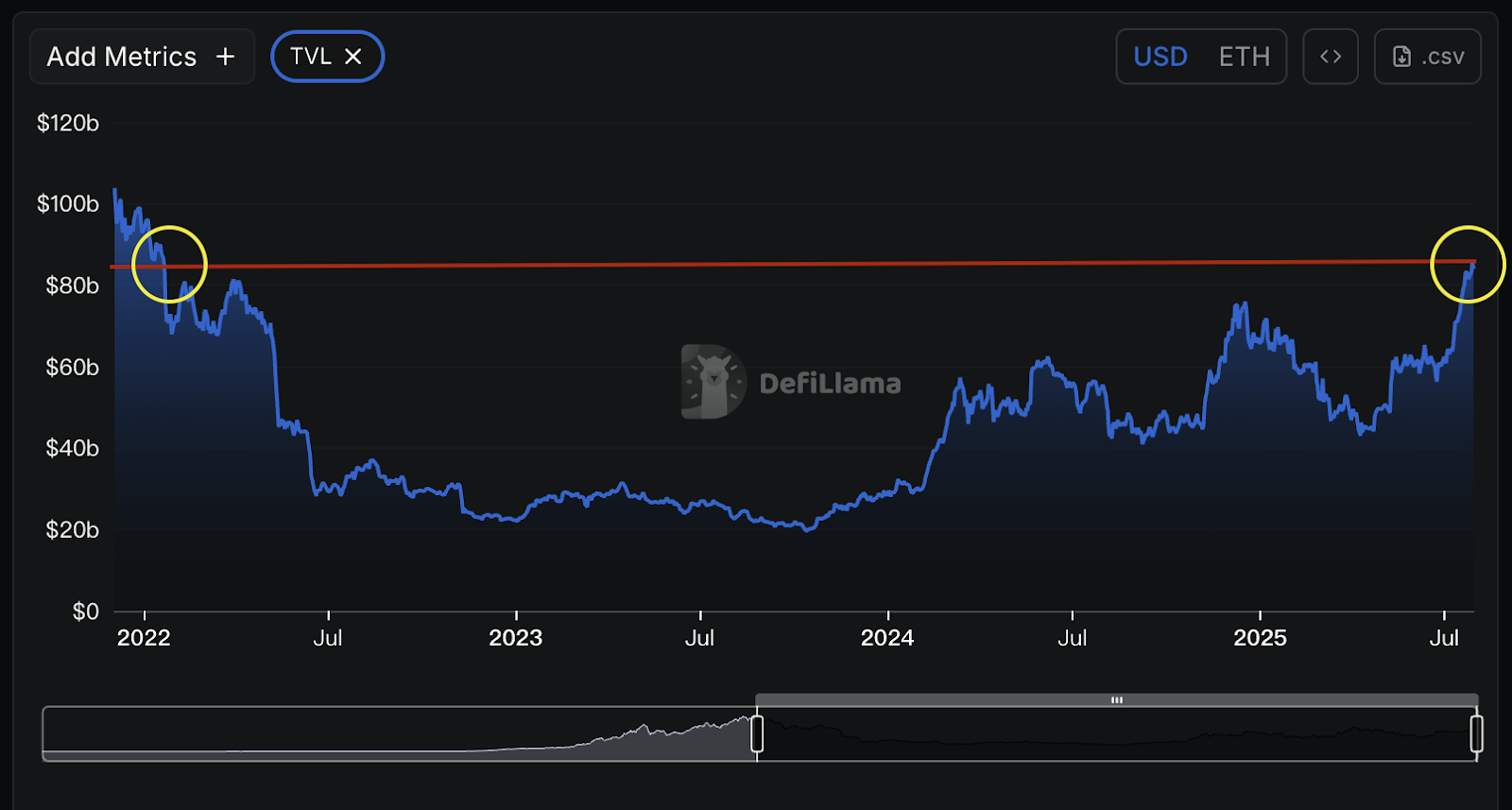
Source: Defillama (The above chart shows ETH TVL)
Staking Situation: It is noteworthy that the scale of Ethereum staking has reached new highs—over 36 million ETH are currently staked, close to 30% of the total supply. These locked ETH effectively reduce the circulating supply, decreasing selling pressure from a supply-demand perspective. Although over 500,000 ETH are queued for unstaking recently, a large amount of new staking has also entered, which can offset the impact of the large exits, and the coin price remains strong, so there is no need for excessive panic.
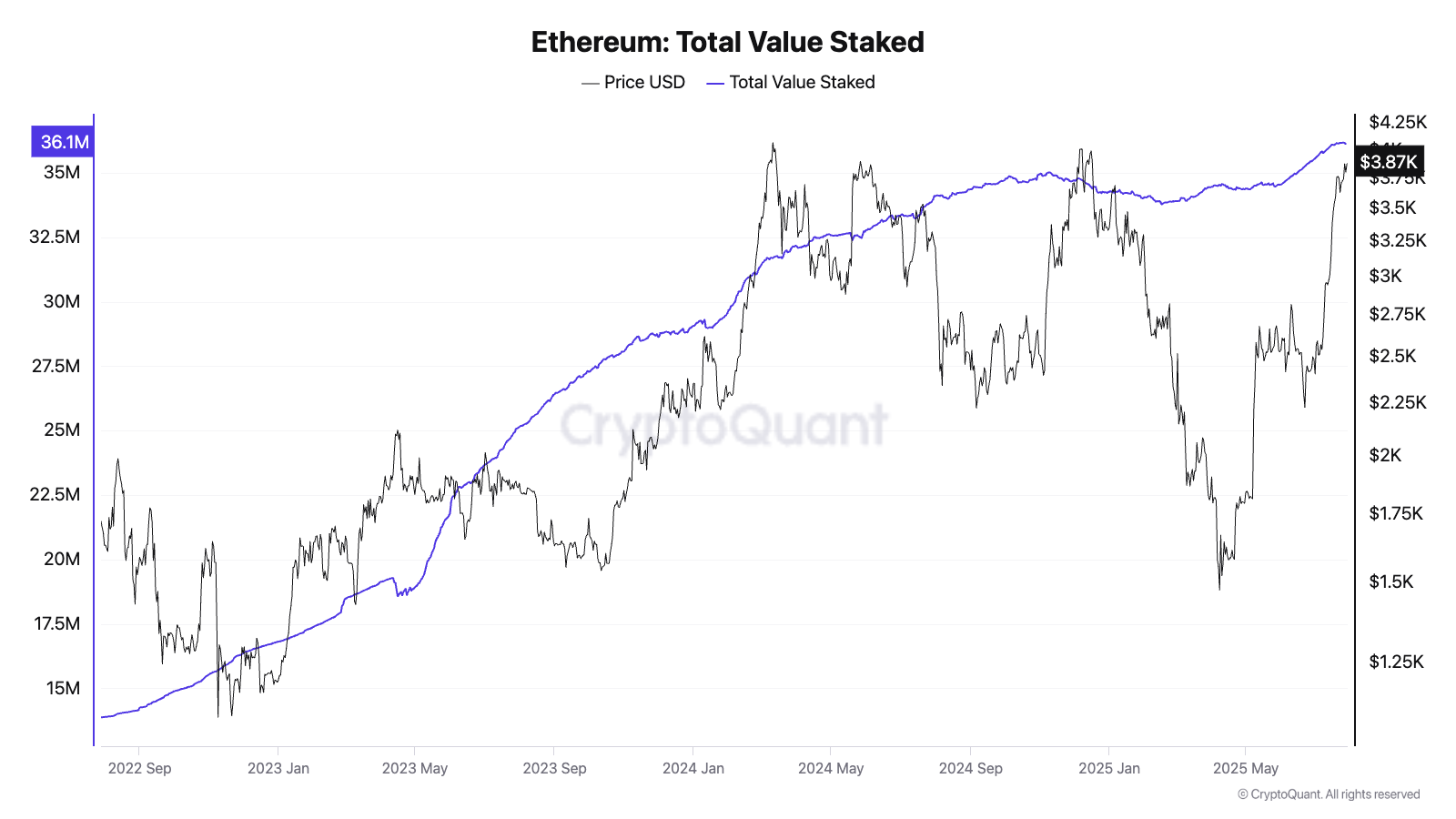
Source: Cryptoquant
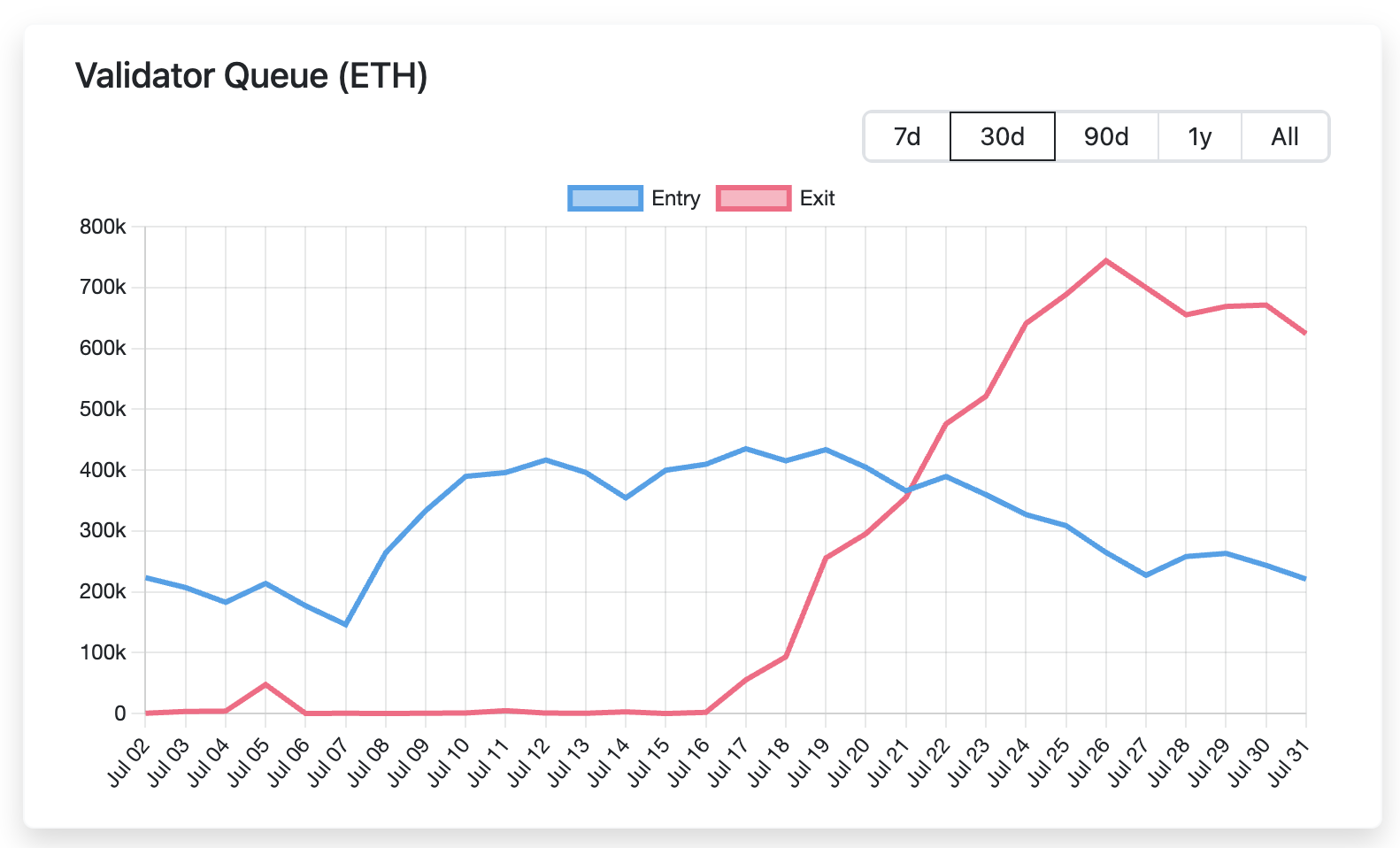
Source: validatorqueue
ETH Inflation Situation: It is noteworthy that the current Ethereum network is exhibiting a slight inflationary state, with the actual inflation rate being far lower than commonly perceived in the market. According to statistics, since the merge, the average annual net inflation rate of Ethereum (+0.117%) over the past three years is more than 11 times lower than Bitcoin's inflation rate (+1.338%). The logic behind ETH is that the more it is used, the more it is burned, creating a positive cycle for network activity. This means that the traditional notion of "ETH having unlimited inflation" is no longer valid; over the past few years, ETH has effectively maintained low inflation, which may be one of the important supports for its price increase.
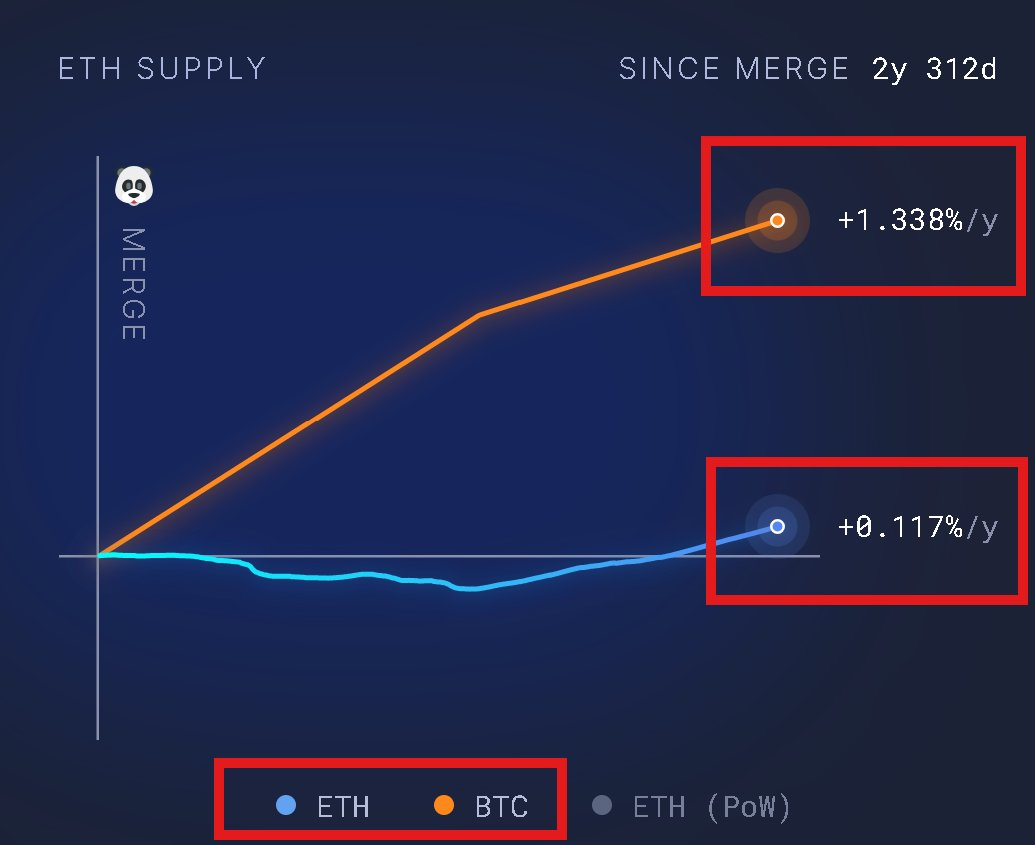
Source: ultrasound.money, @LeonWaidmann
The increase in transaction numbers + the recovery of fees + staking lock-up + low inflation levels collectively support the positive fundamentals of Ethereum, providing strong backing for the continued strength of ETH prices.
6. RWA and Stablecoin Narrative
By analyzing key on-chain metrics supporting RWA across major networks (refer to the table below), it is evident that Ethereum holds a dominant position in the RWA and stablecoin markets.
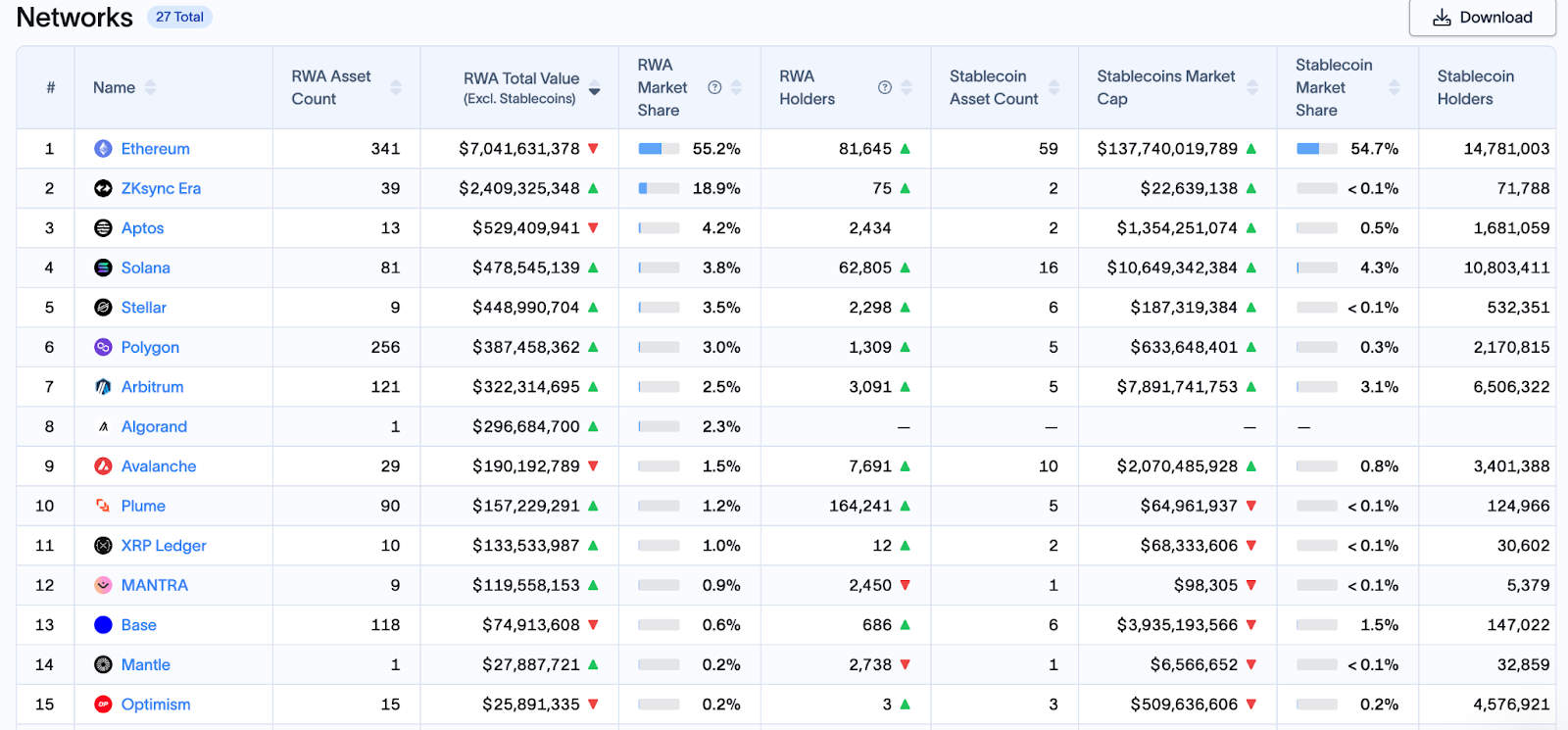
Source: RWA.xyz
RWA On-Chain: The year 2025 is referred to by many industry insiders as the "Year of RWA," with a large number of real-world assets being tokenized through the Ethereum ecosystem. According to RWA.xyz data, as of July 29, 2025, over 341 types of RWA assets have been hosted on Ethereum, covering government bonds, real estate equity, private equity, etc., accounting for approximately 55.2% of the entire on-chain RWA market, valued at $7 billion, leading all blockchains and about three times that of the second-place ZKsync. For example, Blackrock's tokenized fund BUIDL has surpassed $2.4 billion in size, with over 90% of its assets still hosted on Ethereum. As the market size for RWA tokenization continues to grow, Ethereum is expected to capture the largest share.
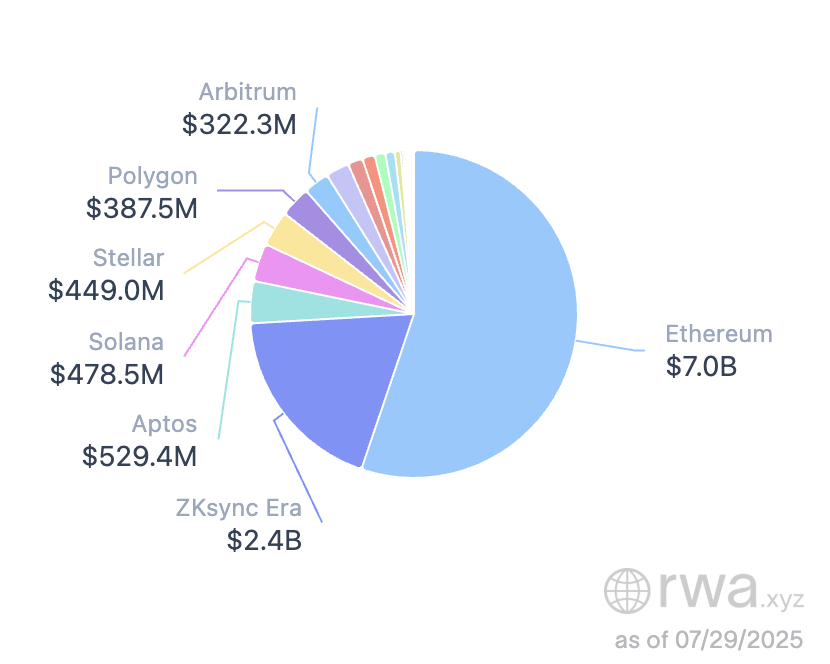
Source: RWA.xyz
Stablecoin Trends: Ethereum continues to solidify its position as the on-chain dollar vehicle in 2025. As of July 29, 2025, the supply of stablecoins operating on Ethereum accounts for over 54% of the entire market, firmly maintaining its lead among all public chains. With a total amount of approximately $250 billion, over $137.7 billion of stablecoins (such as USDT, USDC, etc.) are circulating on the Ethereum network.
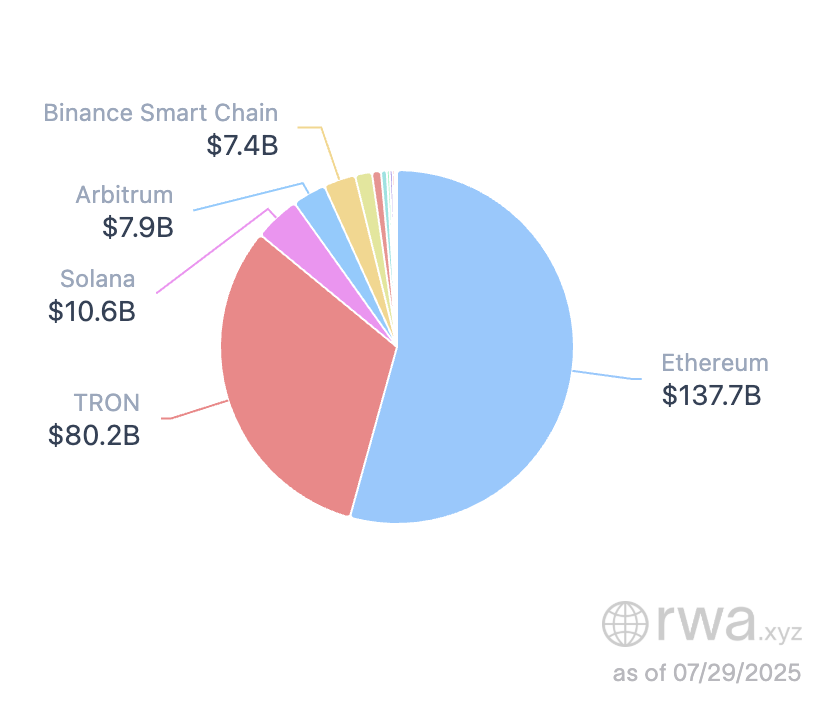
Source: RWA.xyz
It is important to emphasize that in the past, ETH was often viewed as a "super Bitcoin" crypto asset, but now, with the substantial accumulation of stablecoins and RWA, ETH possesses a broader value support. On one hand, ETH is indispensable as the "digital oil" for paying gas fees; every stablecoin transfer and every RWA issuance requires burning a small amount of ETH. On the other hand, the "productive asset" nature of ETH is becoming increasingly prominent—staking ETH can yield native returns, similar to holding U.S. Treasury bonds for interest, aligning with traditional capital's preference for income-generating reserve assets. When entering a rate-cutting cycle, the staking yield of ETH may exceed that of Treasury bonds, and with significant upside potential, this makes ETH extremely attractive. Thomas Lee has boldly stated that Ethereum has unlimited prospects as a stablecoin and RWA carrier platform, making it the preferred choice for Wall Street's compliance-focused blockchain investments. Lee believes that the value of the Ethereum network is severely underestimated, with its "fair value" expected to be in the range of $10,000 to $15,000, and it has the potential to appreciate more than tenfold in the coming years.
In summary, the rise of stablecoins and RWA is redefining the investment value of ETH, giving Ethereum the opportunity to become a global digital dollar settlement network, which is also one of the important reasons why institutional investors are willing to allocate ETH in large amounts recently.
7. Ethereum Technical Roadmap
Ethereum has continued to iterate and upgrade over the past decade, and the progress of its technical roadmap is an important internal driver for bullish sentiment on ETH.

The most recent major upgrade—the Pectra upgrade—was successfully implemented on May 7, 2025. It integrates the Prague and Electra sub-proposals, covering changes to both the execution layer and the consensus layer. It introduces account abstraction (EIP-7702), increases the validator staking cap (to 2048 ETH), expands data capacity (increased blobs), implements a more flexible exit mechanism, and includes BLS precompiles, aiming to enhance scalability and user experience, paving the way for future sharding and Verkle trees, marking a key step in Ethereum's medium to long-term roadmap.
The next phase, the Fusaka upgrade, is expected to go live around the end of 2025, which will expand the number of data blobs per block by eight times and introduce PeerDAS technology to improve on-chain data availability.
Overall, Ethereum's development roadmap has been advancing as planned over the past quarters, focusing on Proto-Danksharding, deepening account abstraction, expanding data capacity, and reforming the validator mechanism, continuously enhancing Ethereum's performance. Looking ahead, Ethereum will strive to complete Danksharding full sharding, achieve Statelessness, and refine various modular components, with the enhancement of Ethereum's performance laying a solid foundation for the long-term value of ETH.
Conclusion
In summary, standing at the ten-year milestone of Ethereum, we can see the resonance between internal fundamentals and external environments: core indicators are improving, technological upgrades are ongoing, and team governance is optimized, making the Ethereum network more robust; at the same time, the emerging narratives of stablecoins and RWA, along with the incremental funds brought in by ETFs, inject continuous upward momentum into ETH. For this reason, an increasing number of asset management institutions and analysts hold an optimistic view on Ethereum's medium to long-term prospects, believing it is likely to challenge new heights in the coming years.
Of course, challenges from other public chains, regulatory changes, and other factors may still bring volatility. However, it is certain that at the starting point of the next decade, Ethereum is transforming into a "new financial infrastructure," and the excitement may just be beginning.
免责声明:本文章仅代表作者个人观点,不代表本平台的立场和观点。本文章仅供信息分享,不构成对任何人的任何投资建议。用户与作者之间的任何争议,与本平台无关。如网页中刊载的文章或图片涉及侵权,请提供相关的权利证明和身份证明发送邮件到support@aicoin.com,本平台相关工作人员将会进行核查。




